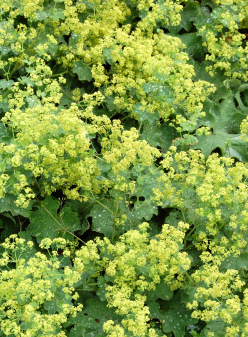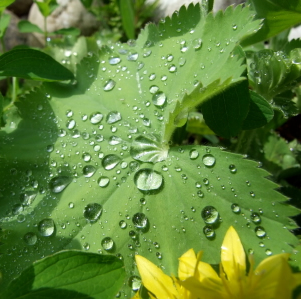Ladys Mantle Alchemilla vulgaris

- Common Names
- Lady's Mantle , Leontopodium, Stellaria
- Botanical Name
- Alchemilla vulgaris
- Syn. A. xanthochlora
- Family
- ROSACEAE
Medicinal Uses & Benefits of Lady's Mantle
![]() How to Use|
Side Effects |
Plant & Garden|
Folklore
How to Use|
Side Effects |
Plant & Garden|
Folklore
- Medicinal Uses: * Cuts & Wounds
* Dysmenorrhea
* Menorrhagia
- Properties: * Appetite Depressant * Astringent * Depurative * Emmenagogue * Refrigerant * Tonic * Vulnerary
- Parts Used: whole herb, root
- Constituents: tannins and flavonoids, chiefly quercetin.
How to Use: Ladys Mantle
Lady's Mantle is found both in the wild and in cultivated gardens. It has a time honored traditional use as a woman's healing herb. It contains salicylic acid and has sedative properties that help to alleviate cramps and painful menstruation. Mantle has astringent and styptic properties, on account of the tannin it contains. Lady's Mantle has a 'drying and binding character', according to the old herbals expressed and was traditionally considered one of the best vulneraries or wound herbs. Cuts, scrapes, and burns can be treated with skin washes of lady's mantle to prevent infection.
Preparation Methods & Dosage :The dried leaves and flowers can be made into teas and extracts.
Ladys Mantle Remedies
Ladys Mantle Side Effects: None noted
Plant Description

Leaf of Lady's Mantle with dew
The plant is only a foot high and green throughout- flowers, stem and leaves alike, and therefore inconspicuous - the rich form of its foliage and the beautiful shape of its clustering blossoms make it worthy of notice. Long-lasting small yellow flowers appear in early summer.
Regional Traditions :European *
How to Grow Ladys Mantle
Though it can be difficult to find in herb stores, it is an easy plant to grow, and deserves a place in every woman's garden both for its beauty and usefulness. The whole herb is gathered in June and July when in flower and when the leaves are at their best, and dried. The root, when employed may be fresh.
Related Species Alchemilla alpina , Alpine Lady's Mantle has similar properties and was once prescribed for obesity.
History and Traditions & Folklore
The name Alchemilla, comes from the Arabic 'alkemelych', alchemist, bestowed by olden writers because of the wonder-working powers of the plant.Like many flowers, this plant was associated with the Virgin Mary in the Middle Ages. (hence the name Lady's not Ladies Mantle). Many believed that alchemical virtues lay in the subtle influence the rich accordion foliage imparted to the dewdrops that lay within it's leaves, these dewdrops were used in many mystic potion. In Sweden an old authority states that if placed under the pillow at night the herb will promote a good nights sleep.











